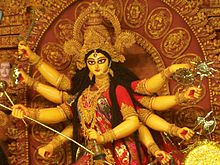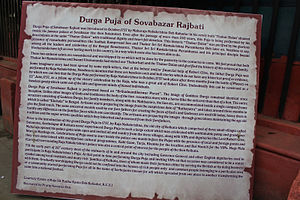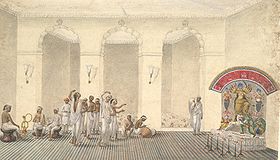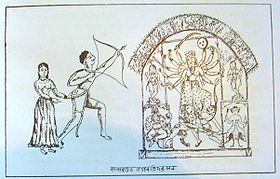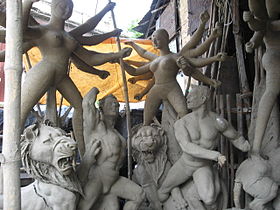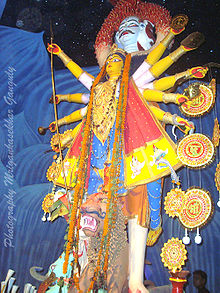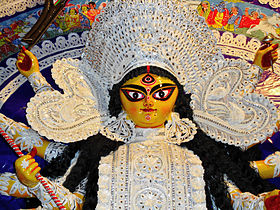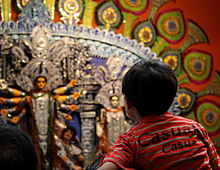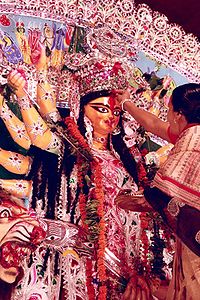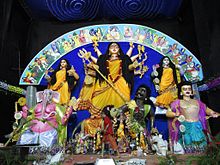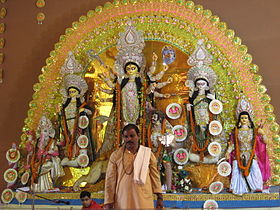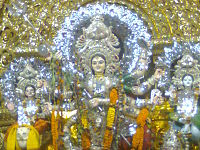- Durga Puja
-
Durga Puta
Durga and her family at Bagbazar Sarbojonin, North KolkataOfficial name Durga Puja Also called Akaal Bodhan (Bengali: অকাল বোধন) Observed by Hindus Type Hindu, Indian Begins First day of month Ashvin[1] Ends Ninth day of month Ashvin[2] 2010 date 8 October–17 October 2011 date 27 September-6th October Related to Navratri, Dussehra PracticesDurga puja (pronounced [ˈd̪ʊrɡaː ˈpuːdʒaː]; (listen:
 Durga Puja (help·info)); Bengali: দুর্গা পূজা,Oriya: ଦୁର୍ଗା ପୂଜା,‘Worship of Durga’), also referred to as Durgotsava (listen:
Durga Puja (help·info)); Bengali: দুর্গা পূজা,Oriya: ଦୁର୍ଗା ପୂଜା,‘Worship of Durga’), also referred to as Durgotsava (listen: Durgotsava (help·info)); (Bengali: দুর্গোৎসব, ‘Festival of Durga’), is an annual Hindu festival in South Asia that celebrates worship of the Hindu goddess Durga. It refers to all the six days observed as Mahalaya, Shashthi, Maha Saptami, Maha Ashtami, Maha Navami and Vijayadashami. The dates of Durga Puja celebrations are set according to the traditional Hindu calendar and the fortnight corresponding to the festival is called Devi Paksha (Bengali:দেবী পক্ষ, ‘Fortnight of the Goddess’). Devi Paksha is preceded by Mahalaya (Bengali: মহালয়া), the last day of the previous fortnight Pitri Paksha (Bengali: পিতৃ পক্ষ, ‘Fortnight of the Forefathers’), and is ended on Kojagori Lokkhi Puja (Bengali: কোজাগরী লক্ষ্মী পূজা, ‘Worship of Goddess Lakshmi on Kojagori Full Moon Night’).
Durgotsava (help·info)); (Bengali: দুর্গোৎসব, ‘Festival of Durga’), is an annual Hindu festival in South Asia that celebrates worship of the Hindu goddess Durga. It refers to all the six days observed as Mahalaya, Shashthi, Maha Saptami, Maha Ashtami, Maha Navami and Vijayadashami. The dates of Durga Puja celebrations are set according to the traditional Hindu calendar and the fortnight corresponding to the festival is called Devi Paksha (Bengali:দেবী পক্ষ, ‘Fortnight of the Goddess’). Devi Paksha is preceded by Mahalaya (Bengali: মহালয়া), the last day of the previous fortnight Pitri Paksha (Bengali: পিতৃ পক্ষ, ‘Fortnight of the Forefathers’), and is ended on Kojagori Lokkhi Puja (Bengali: কোজাগরী লক্ষ্মী পূজা, ‘Worship of Goddess Lakshmi on Kojagori Full Moon Night’).Durga Puja is widely celebrated in the Indian states of Assam, Bihar, Jharkhand, Orissa, Tripura and West Bengal, where it is a five-day annual holiday.[3] In West Bengal and Tripura, which has majority of Bengali Hindus it is the biggest festival of the year. Not only is it the biggest Hindu festival celebrated throughout the State, but it is also the most significant socio-cultural event in Bengali society. Apart from eastern India, Durga Puja is also celebrated in Delhi, Uttar Pradesh, Maharashtra, Gujarat, Punjab, Kashmir, Karnataka and Kerala. Durga Puja is also celebrated as a major festival in Nepal and in Bangladesh where 10% population are Hindu. Nowadays, many diaspora Bengali cultural organizations arrange for Durgotsab in countries such as the United States, Canada, United Kingdom, Australia, Germany, France, The Netherlands, Singapore and Kuwait, among others. In 2006, a grand Durga Puja ceremony was held in the Great Court of the British Museum.[4]
The prominence of Durga Puja increased gradually during the British Raj in Bengal.[5] After the Hindu reformists identified Durga with India, she became an icon for the Indian independence movement.[6] In the first quarter of the 20th century, the tradition of Baroyari or Community Puja was popularised due to this. After independence, Durga Puja became one of the largest celebrated festivals in the whole world.
Durga Puja also includes the worship of Shiva, who is Durga's consort, and worship of mother nature through nine types of plant (called "kala bou") representing nine divine forms of Goddess Durga[7] is also done in addition to Lakshmi, Saraswati with Ganesha and Kartikeya, who are considered to be Durga's children.[8] Modern traditions have come to include the display of decorated pandals and artistically depicted idols (murti) of Durga, exchange of Vijaya greetings and publication of Puja Annuals.
Names
In Bengal, Durga Puja is also called Akalbodhan (Bengali: অকালবোধন, 'untimely awakening of Durga'), Sharadiya Pujo (Bengali: শারদীয়া পুজো , ‘autumnal worship’), Sharodotsab (Bengali: শারদোৎসব, ‘festival of autumn’), Maha Pujo (Bengali: মহা পুজো, ‘grand puja’), Maayer Pujo (Bengali: মায়ের পুজো, ‘worship of the Mother) or merely as Puja or Pujo. In East Bengal (Bangladesh), Durga Puja used to be celebrated as Bhagabati Puja. It is also called Durga Puja in Bihar, Assam, Orissa, Delhi and Madhya Pradesh.[9]
Puja is called Navaratri Puja in Gujarat, Uttar Pradesh, Punjab, Kerala and Maharashtra,[10] Kullu Dussehra in Kullu Valley, Himachal Pradesh,[11] Mysore Dussehra in Mysore, Karnataka[12] and Bommai Golu in Tamil Nadu and Bommala koluvu in Andhra Pradesh.[13]
Origin of the autumnal ceremony 'Sharadiya'
The actual worship of the Goddess Durga as stipulated by the Hindu scriptures falls in the month of Chaitra, which roughly overlaps with March or April. This ceremony is however not observed by many and is restricted to a handful in the state of West Bengal. The more popular form, which is also known as Sharadiya (Autumnal) Durga Puja, is celebrated later in the year with the dates falling either in September or October.[14] Since the Goddess is invoked at the wrong time, it is called "Akaal Bodhon" in Bengali.
While the most recent revival of the Autumnal worship of Goddess Durga can be traced to revivalist tendencies in the early freedom movement in Bengal, differences remain in the historical reason behind the revival. One school of thought is of the opinion that the first such Puja was organised by Raja Nabakrishna Deb of the Shobhabazar Rajbari of Calcutta in honour of Lord Clive in the year 1757. The puja was organised because Clive wished to pay thanks for his victory in the Battle of Plassey. He was unable to do so in a Church because the only church in Calcutta at that time was destroyed by Siraj-ud-Daulah. Indeed many wealthy mercantile and Zamindar families in Bengal made British Officers of the East India Company guests of honour in the Pujas. The hosts vied with one another in arranging the most sumptuous fares, decorations and entertainment for their guests. This was deemed necessary since the Company was in charge of a large part of India including Bengal after the battles of Plassey and Buxar.[15] However, this particular claim has been refuted by the Sovabazar Rajbari. In a public announcement during the Durga Puja of 2011, notice boards were placed at the entrance of the puja, clarifying the Rajbari's official position.
History
A considerable literature exists around Durga in the Bengali language and its early forms, including avnirnaya (11th century), Durgabhaktitarangini by Vidyapati (a famous Maithili poet of 14th century), etc. Durga Puja was popular in Bengal in the medieval period, and records show that it was being held in the courts of Rajshahi (16th century) and Nadia district (18th century). It was during the 18th century, however, that the worship of Durga became popular among the landed aristrocacy of Bengal, the Zamindars. Prominent Pujas were conducted by the landed zamindars and jagirdars, being enriched by emerging British rule, including Raja Nabakrishna Deb, of Shobhabajar, who initiated an elaborate Puja at his residence. Many of these old puja exist to this day. Interestingly the oldest such Puja to be conducted at the same venue is located in Rameswarpur, Orissa, where it has been continuing for the last four centuries since the Ghosh Mahashays from Kotarang near Howrah migrated there as a part of Todarmal's contingent during Akbar's rule. Today, the culture of Durga Puja has shifted from the princely houses to Sarbojanin (literally, "involving all") forms. The first such puja was held at Guptipara - it was called barowari (baro meaning twelve and yar meaning friends)
Today's Puja, however, goes far beyond religion. In fact, visiting the pandals recent years, one can only say that Durgapuja is the largest outdoor art festival on earth. In the 1990s, a preponderance of architectural models came up on the pandal exteriors, but today the art motif extends to elaborate interiors, executed by trained artists, with consistent stylistic elements, carefully executed and bearing the name of the artist.
The sculpture of the idol itself has evolved. The worship always depicts Durga with her four children, and occasionally two attendant deities and some banana-tree figures. In the olden days, all five idols would be depicted in a single frame, traditionally called pata. Since the 1980s however, the trend is to depict each idol separately.
Customs
Durga puja mood starts off with the Mahishasuramardini – a two-hour radio programme that has been popular with the community since the 1950s.[16] While earlier it used to be conducted live, later a recorded version began to be broadcast. Bengalis traditionally wake up at 4 in the morning on Mahalaya day to listen to the enchanting voice of the late Birendra Krishna Bhadra and the late Pankaj Kumar Mullick on All India Radio as they recite hymns from the scriptures from the Devi Mahatmyam (Chandi Path).[17]
During the week of Durga Puja, in the entire state of West Bengal as well as in large enclaves of Bengalis everywhere, life comes to a complete standstill. In playgrounds, traffic circles, ponds—wherever space may be available—elaborate structures called pandals are set up, many with nearly a year's worth of planning behind them. The word pandal means a temporary structure, made of bamboo and cloth, which is used as a temporary temple for the purpose of the puja. While some of the pandals are simple structures, others are often elaborate works of art with themes that rely heavily on history, current affairs and sometimes pure imagination.
Somewhere inside these complex edifices is a stage on which Durga reigns, standing on her lion mount, wielding ten weapons in her ten hands. This is the religious center of the festivities, and the crowds gather to offer flower worship or pushpanjali on the mornings, of the sixth to ninth days of the waxing moon fortnight known as Devi Pakshya (lit. Devi = goddess; Pakshya = period; Devi Pakshya meaning the period of the goddess). Ritual drummers – dhakis, carrying large leather-strung dhak –– show off their skills during ritual dance worships called aarati. On the tenth day, Durga the mother returns to her husband, Shiva, ritualised through her immersion into the waters[18]–– Bishorjon also known as Bhaashan and Niranjan
At the end of six days, the idol is taken for immersion in a procession amid loud chants of 'Bolo Durga mai-ki jai' (glory be to Mother Durga') and 'aashchhe bochhor abar hobe' ('it will happen again next year') and drumbeats to the river or other water body. It is cast in the waters symbolic of the departure of the deity to her home with her husband in the Himalayas. After this, in a tradition called Vijaya Dashami, families visit each other and sweetmeats are offered to visitors (Dashami is literally "tenth day" and Vijay is "victory").
Durga Puja commemorates the annual visit of the Goddess with Her children to Her parents' home, leaving finally on the Dashami to be re-united with Shiva. This leaving ceremony is symbolised by the immersion of the idols on Dashami.[9]
Durga Puja is also a festivity of Good (Ma Durga) winning over the evil (Mahishasur the demon). It is a worship of power of Good which always wins over the bad.
Durga Puja Mantra
Mantras, the integral part of Durga puja are accompanied by the rhythmic beatings of the dhak, smell of the incense sticks, 'dhoono' and flowers. These create the atmosphere of Durga puja. Chanting of mantras in Sanskrit is essential part of the Durga Puja Festival.[19] This is a part of Durga Puja's Pushpanjali Mantra:
“ Om Jayanti, Mangala, Kali, Bhadrakali, Kapalini. Durga, Shiba, Kshama, Dhatri, Swaha, Swadha Namahstu Te. Esha Sachandana Gandha Pushpa Bilwa Patranjali, Om Hrring Durgaoi Namah[20]
” Evolution of the Community or Sarbajanin puja
Initially the Puja was organised by affluent families since they had the money to organize the festival. During the late 19th and early 20th century, a burgeoning middle class, primarily in Calcutta, wished to observe the Puja. They created the community or Sarbojanin Pujas.
These Pujas are organized by a committee which represents a locality or neighbourhood. They collect funds called "chaanda" through door-to-door subscriptions, lotteries, concerts etc. These funds are pooled and used for the expenses of pandal construction, idol construction, ceremonies etc. The balance of the fund is generally donated to a charitable cause, as decided by the committee. Corporate sponsorships of the Pujas have gained momentum since the late 1990s. Major Pujas in Calcutta and in major metro areas such as Delhi and Chennai now derive almost all of their funds from corporate sponsorships. Community fund drives have become a formality.
Despite the resources used to organise a Puja, entry of visitors into the Pandal is generally free. Pujas in Calcutta and elsewhere experiment with innovative concepts every year. Communities have created prizes for Best Pandal, Best Puja, and other categories.
Creation of the idols
The entire process of creation of the idols (murti) from the collection of clay to the ornamentation is a holy process, supervised by rites and other rituals. On the Hindu date of Akshaya Tritiya when the Ratha Yatra is held, clay for the idols is collected from the banks of a river, preferably the Ganges. There is age-old custom of collecting a handful of soil (punya mati) from the nishiddho pallis of Calcutta, literally ‘forbidden territories’, where sex workers live, and adding it to the clay mixture which goes into the making of the Durga idol. [21] After the required rites, the clay is transported from which the idols are fashioned. An important event is 'Chakkhu Daan', literally donation of the eyes. Starting with Devi Durga, the eyes of the idols are painted on Mahalaya or the first day of the Pujas. Before painting on the eyes, the artisans fast for a day and eat only vegetarian food.
Many Pujas in and around Kolkata buy their idols from Kumartuli (also Kumortuli), an artisans' town in north Calcutta.[22]
In 1610, the first Durga puja in Kolkata was supposedly celebrated by the Roychowdhuri family of Barisha. Though this was a private affair, community or ‘Baroyari’ Durga puja was started in Guptipara, in Hooghly by 12 young men when they were barred from participating in a family Durga puja in 1761. They formed a committee which accepted subscriptions for organising the puja. Since then, community pujas in Bengal came to be known as ‘Baroyari – ‘baro’ meaning 12 and ‘yar’ meaning friends.In Kolkata, the first ‘Baroyari’ Durga Puja was organized in 1910 by the ‘SanatanDharmotsahini Sabha’ at Balaram Bosu Ghat Road, Bhawanipur. At the same time, similar Baroyari Pujas were held at Ramdhan Mitra Lane and Sikdar Bagan. The Indian freedom struggle also had an influence on Durga puja in Kolkata. In 1926, Atindranath Bose initiated the first ‘Sarbojanin’ Durga puja in which anybody, irrespective of caste, creed and religion, could participate in the festivities. This was consciously done to instill a feeling of unity.[23]
Environmental impact
Environmental hazards from the materials used to make and color the idols pollute local water sources, as the idols are brought directly into the river at the end of festivities. Efforts are underway to introduce eco-friendly materials to the artisans who make the idols. West Bengal has been credited by its own environmental agency as being possibly the first Indian State to successfully curb the use of hazardous paints. However, by their own account, only two-thirds of the idols made are currently colored with eco-friendly paints.[24]
Commercialization of Hindu festivals like Durga Puja in the last quarter of 20th century have become a major environmental concern as devout Hindus want bigger and brighter idols. Environmentalists say the idols are often made from hazardous materials like cement, plastic, plaster of Paris, and toxic paints.[25]
Theme-based Pujas and pandals
Pandals and idols inspired by a particular theme have been the hallmark of many community or Sarbajanin Pujas in Kolkata since the 1990s. Puja committees decide on a particular theme, whose elements are incorporated into the pandal and the idols. Popular themes include ancient civilizations like the Egyptians or Incas. Contemporary subjects like the RMS Titanic and Harry Potter have also been the subject in some pandals.
The design and decoration is usually done by art and architecture students based in the city. The budget required for such theme-based pujas is often higher than traditional pujas. They attract crowds and are well-received. Inspired by Kolkata, theme-based pandals are becoming popular in cities in neighbouring states, particularly Orissa (see above). Experimentation with the idols does not happen much outside Calcutta.
Rapid growth of competitiveness in theme pandals, and also rapid growth of massive billboards that come up at strategic junctions, prior to Puja and allied commercial activities, has also created a cultural backlash from city's traditional Puja pandals, which now claim, "We do not do theme puja, we do Durga puja,”, according to one hoarding put up in Salt Lake, Kolkata.[26]
Popular culture specific to the puja
Durga Puja is one of the most important events in the Bengali society's calendar. Many Bengali films, albums and books are released to coincide with the Puja. The West Bengal government gives a fortnight of holidays for the Pujas. This time is used in various ways. Many people travel in India or abroad. Gatherings of friends called "Aadda" in Bengali is common in many homes and restaurants. A lot of shopping is done, and retailers cash in on this opportunity with special offers.
Visiting pandals with friends and family, talking and sampling the food sold near them is known as pandal hopping. Young people embrace this activity. Pujor Gaan (Songs of Puja) are the Adhunik Bengali songs that come out every year during this time.
Media Attention
TV and radio channels telecast Puja celebrations. Many Bengali channels devote whole days to the Pujas. Bengali and Oriya weekly magazines bring out special issues for the Puja known as "Pujabarshiki" or "Sharadiya Sankhya". These contain the works of many writers both established and upcoming and are thus much bigger than the regular issues. Some notable examples are Anandamela, Shuktara, Desh, Sarodiya Anandabazar Patrika, Sananda, Nabakallol, Bartaman[27]
Movies
- Famous director Satyajit Ray's film Joi Baba Felunath is centred around Durga Puja and his movie Nayak also has a Durga Puja reference.[28]
- Rituporno Ghosh's Hirer Angti, Utsav and Antarmahal all are centred around Durga Puja.
- The Hindi film "Devdas" interweaves the celebration of Durga Puja into its story line.
Bengal
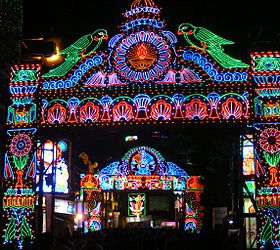 Characteristic neon light images glow as late night revelers throng the streets of Kolkata during Durga Puja.
Characteristic neon light images glow as late night revelers throng the streets of Kolkata during Durga Puja.
The worship of Durga in the autumn (Bengali: শরৎ Shôrot) is the year's largest Hindu festival of Bengal. Durga Puja is also celebrated in Nepal and Bhutan according to local traditions and variations. Puja means "worship," and Durga's Puja is celebrated from the sixth to tenth day of the waning moon in the month of Ashvin (Bengali: আশ্বিন Ashshin), which is the sixth month in the Bengali calendar. Occasionally however, due to shifts in the lunar cycle relative to the solar months, it may also be held in the following month, Kartika (Bengali: কার্তিক). In the Gregorian calendar, these dates correspond to the months of September and October.
In the Krittibas Ramayana, Rama invokes the goddess Durga in his battle against Ravana. Although she was traditionally worshipped in the spring, due to contingencies of battle, Rama had to invoke her in the autumn akaal bodhan.[29] Today it is this Rama's date for the puja that has gained ascendancy, although the spring puja, known as Basanti Puja [One of the oldest 'sabeki' Basanti Puja is held every year at spring in Barddhaman Pal Bari at Raniganga Bazar, M.K.Chatterjee Rd near Karjon Gate], is also present in the Hindu almanac. Since the season of the puja is autumn, it is also known as (Bengali: শারদীয়া 'Sharodia').
The pujas are held over a ten-day period, which is traditionally viewed as the coming of the married daughter, Durga, to her father, Himalaya's home. It is the most important festival in Bengal, and Bengalis celebrate with new clothes and other gifts, which are worn on the evenings when the family goes out to see the 'pandals' (temporary structures set up to venerate the goddess). Although it is a Hindu festival, religion takes a back seat on these five days: Durga Puja in Bengal is a carnival, where people from all backgrounds, regardless of their religious beliefs, participate and enjoy themselves to the hilt.[30]
Kolkata (Calcutta)
In Kolkata alone more than two thousand pandals are set up, all clamoring for the admiration and praise of the populace.[31] The city is adorned with lights. People from all over the country visit the city at this time, and every night is one mad carnival where thousands of people go 'pandal-hopping' with their friends and family. Traffic comes to a standstill, and indeed, most people abandon their vehicles to travel by foot after a point. A special task force is deployed to control law and order. Durga Puja in Kolkata is often referred to as the Rio Carnival of the Eastern Hemisphere.[32]
Konnagar, Hooghly
One of oldest Durga Puja is held at Konnagar. it is well known to the people of the bengal. the nearest durga puja uttarpara and srirampur is also well known. konnagar's BOISAKHI is the most toppest pandel, not only the DEBPARA also going to be a toppest one in a few years.[33]
Siliguri
Hundreds of puja pandals are set up every year in the Siliguri Mahakuma area. The city is adorned with many colourful pandal, glorious "Protima", colourful lighting and sounds. The puja in Saktigarh, Hakimpara, Rabindra Sangha, Rathkhola, Champashari, Central Colony (N.R.I), Silpanchal(Burdwan Road) and Saktigarh Utjal Sangha,sorojini sangha[shivmandir] are famous and the oldest durga puja in this area.
Silpanchal Durga Puja committee is recognized as one of the oldest puja is town which was established in 1955 and is famous for the "Protima" and many other social activities they undertake during Pujas.
The oldest puja in Siliguri is of Swastika Yubak Sangha. It's one of the most crowd gathering puja of the region. The Puja Committee completed its 50th year of celebrations in 2009. "Sorjini sangha completed its 150th year recently.
Chanduli, Katwa
One of oldest Durga Puja is held at a village named Chanduli, 12 km from Katwa city, which is more than 350 years old. The Puja is held under the auspices of Mitra bari Debottor estate and here Goddess Durga has two hands visible in place of ten hands. Here, Devi Durga is glorious and famous in this locality. Guptipara
In 1790 First Barwary puja held in this village of West Bengal in the district of Hooghly.[34] Great Goswami family of Dhaka is now at Guptipara led by Satyendra Nath Goswami, Roypara.
Lataguri
Lataguri is a small village in Jalpaiguri district. It has an old tradition of Durga Puja with lots of joy and cultural values in the heart of the people. Prantik Sangha, Netaji Sangha, Friends Club, Pal Chowdhury Bari (Family Puja) are some of the oldest pujas to name a few. In the day of Shashthi, Maha Saptami, Maha Ashtami, Maha Nabami and Bijoya Dashami people here celebrate it in a grand way with lots of joy. Specially in Prantik Sangha (Post Office Para) they have an old tradition of celebrating "Raksha Raksha" (Prayers offered to Durga to save whole body and mind and to give happiness and prosperity) by exchanging warmth of happiness and respect among the people with touching elder person's feet and hugging each other. After that small sweet balls laddu are distributed among the people. "Raksha Raksha" is celebrated in the day of Bijoya Dashami after idols (murtis) of Goddess Durga with her family are immersed in the most convenient body of water. The members of Pal Chowdhury Bari march to the pond near about half a kilometer for immersion of the goddess by taking it on their shoulder. This tradition has been following for 61 years.
Berhampore
Hundreds of puja pandals are set up every year in the Berhampore, Cossimbazar, Khagra jagdamba mandir (kajal saha & ganesh bhakat MULTIFRESH, Madhupur, Gorabazaar area. All pandal are decorated with lights and sounds. Swarnamoyee, Baganpara, Bishtupur, Madhupur Balark Sangha, Ranibagan, Kadai, Swargadham, Ajana Sangha, Cossimbazar Choto Rajbari are famous and the oldest durga puja from this area. Cossimbazars Puja is the oldest puja which is about 300 years old. All visitors are mostly from Berhampore city and coming through different part of Murshidabad.[35] district and adjacent districts. Specially the Astami and Nabami nights are filled with crowd from different part of the district. Visitors come out on the roads with their family and friends. They enjoy the festival through the night. Also the Bisorjon (immersion of idol) to Bhagarathi River is a beautiful scene. A huge number of visitors gather on the river side (Gorabajar Ghat, Khagra Ghat) to visit the last journey of Durga Pratima. Generally the pandals and idols of Madhupur area win the prizes and famous artists perform during these days. Lighting from Chandan Nagar is done in this area to a great extent to increase the beauty of the Puja nights.
In other parts of India
Assam
In Silchar more than 300 exhibits, known as pandals, decorated with lights, sculptures and other art forms are created. After Bihu, Durga Puja is the most popular festival of Assam. According to historian Late Benudhar Sarma, the present form of worship of Durga with earthen idol in Assam was started during the reign of Ahom King Susenghphaa or Pratap Singha. The King heard about the festivity, the pomp and grandeur with which the King Naranarayan of Koch Bihar celebrated Durga Puja from one Sondar Gohain, who was under captivity of the Koch raja. King Pratap Singha sent artisans to Koch Bihar to learn the art of idol making. The King organised the first such Durga Puja celebration in Bhatiapara near Sibsagar. This was the first time Durga Puja with earthen idols in Assam was held for the masses, in addition to the worship in Durga temples like Kamakhya, Digheswari Temple, Maha Bhairabi Temple, Ugrotara, Tamreswari Mandir, etc. Subsequently, similar Pujas were celebrated by other Kings and nobles. Nowadays the Durga Puja is mostly a community festival celebrated in all the cities, towns, villages of Assam with great festivity and religious fervour for five days.
Bihar
Durga Puja is one of the major festivals in Bihar. Hundreds of pandals are set up with carnivals. The city witnesses a huge surge in visitors in the four days from Maha Saptami. More than 100exhibits, known as pandals, decorated with lights, sculptures and other art forms are created. Ancient Places of Patna Durga Puja includes Bari and Chhoti PatanDevi Maa Shitla Mandir Agamkuan etc. After Chath, Durga Puja is the most popular festival of Bihar.
Gujarat
Navaratri is devoted to Amba mataji. In some homes, images of mataji are worshiped in accordance with accepted practice. This is also true of the temples, which usually have a constant stream of visitors from morning to night. The most common form of public celebration is the performance of garba and dandia-ras/ras-garba (a form of garba with sticks), Gujarat's popular folk-dance, late throughout the nights of these nine days in public squares, open grounds and streets.[36]
Jharkhand
Durga Puja is celebrated with many carnivals. The festival mood starts from Mahalaya, a huge surge in visitors is witnessed during the last four days of the festival, arriving from cities like Jamshedpur (TATA), Ranchi, Dhanbaad, etc. There are so many pandals as like as at Kolkata and Cuttack which makes interesting and enjoyful in these days at there. Some of highlighted Pandals are:
- Adityapur (by Jai Ram Youth Sporting Club Jamshedpur, near Kharhkhai Bridge)
- Kashidih (by Thakur Pyara Singh Dhurandhar Singh club, Jamshedpur)
- Bhuyandih (by Dulal BHuyan Club)
- Rani Kudar (by Hind Club)
- Sakchi, Aam Bagan (by Bengal Club)
- Kadma and Farm Area, Jamshedpur
- Mango, Jamshedpur
- Sonari, Jamshedpur
- Birsanagar, Jamshedpur
- Bhalubasa, Jamshedpur
- 26 No. Road Telco, Jamshedpur
Karnataka
Durga Puja is celebrated in a grand way in this state. In Mysore, Dussehra is easily the most popular festival. Elephants are decked up with robes and jewellery and taken in processions through the streets of the city. In fact, many people visit Mysore from all over the country to watch this colorful event. There is also a floating festival in the temple tank at the foot of Chamundi Hill and a procession of chariots around the temple at the top.
Mysore is named after Mahishasur, the very demon which was slain by the Goddess. The original Indian name was Mahishur. There are temples dedicated to the demon king and even a gigantic statue of the demon in the city.
Kashmir
Hindus in Jammu and Kashmir celebrate their festivals with pomp and show. These days, festivities are more subdued. The favorite deities of Kashmir are Lord Shiva and Serawali Ma Durga, the one who rides the tiger. Pundits\Dogris and Muslims alike vouch that Navratri is important. Here each Hindu household does the puja at home. All the adult members of the household fast on water. In the evenings, fruit may be taken. As elsewhere, Dogris grow barley in earthen pots. They believe that if the growth in this pot is good, there is prosperity all year. The most important ritual for Kashmiri Pandits is to visit the temple of guardian goddess Kheer Bhawani on all nine days. On the last day of Navratri, an aarti is held at the temple, after which people break their fast. On Dussehra day, Ravana's effigy is burnt.
Kerala
In Kerala, Durga Puja signifies the beginning of formal education for every child aged 3–5 years. While puja goes on in the temple for all ten days, it is the concluding three days which are most important. Ashtami is the day of Ayudya Puja, when all the tools at home are worshipped. Custom dictates that no tools be used on this day. On navami day, Goddess Saraswati is honored by worshipping the books and records at home.[37]
Thousands throng the Saraswati temple at Kottayam during this period to take a dip in the mysterious holy pond, whose source is yet unknown. Large gatherings are also seen at the famous temples at Thekkegram (Palghat), in which there are no idols, only huge mirrors. A devotee finds himself bowing before his own reflection, which symbolizes that God is within us.
Thrikkavu Temple, a famous Durga Devi Temple at Ponnani, Malapuram District of Kerala, is also famous for Navaratri festival and vidyarambham (beginning of formal education). Thousands of children throng this temple on vijaya desami day for vidyarambham. Santhanantha Matom at Mangadu in Kollam observes Navaratri festival with all the religious purity and rituals. On the tenth day, The Vijaya desami, Children perform Vidyarambham here not only for education, but also for various arts and music.
Maharashtra and Goa
In Maharashtra, Durga Puja is an enjoyable occasion. Puja is performed each day and devotees do not remove the flower garland that is put each day on the idol or image of the deity. After nine days, all nine garlands are removed together. Young girls who have not attained maturity are invited to eat, play games, dance and sing. An elephant is drawn with rangoli, and the girls play guessing games.It is called as 'bhodala' Then they are fed a meal of their choice.In maharastra there is also played 'Jogava' & 'Gondhal' for Goddess.
Nashik boasts of four major ones celebrated by "prabashi" Bengalis' – like the ones at the Government of India Press grounds, the Hindustan Aeronautics Limited (H.A.L)in Ojhar, then the one at Artillery Station,Deolali and one in the industrial area of Satpur-Ambad.
In Goa great festivities take place in all the temples,especially Devi temples like of shree Shantadurga, shree Mhalasa Narayani, shree Vijayadurga.Preople fast and observe festivities at home.
New Delhi
In 1910, a year before Delhi was declared the capital of British India, the first sArbojanIn (community) puja in Delhi was organized near Kashmiri Gate by a group of expatriate Bengalis, including the doctor Hemchandra Sen. This group became the Delhi Durga Puja Samiti, popularly known as the Kashmere Gate Puja.[38] The Timarpur puja (near Delhi University) started in 1914[39]. The pujas at Minto Road and Mata Sundari Road started shortly thereafter. By the 1970s, 40 pujas were being held in Delhi[40]
Today, over 800 pujas are held in Delhi, with a few hundred more in Gurgaon and Noida each[41]. By the 1970s, 40 pujas were being celebrated in Delhi, with many theater troupes performing. Bengali movies would be screened late into the night at many pandals[42]. Today movies have given way to cultural functions, with many of the top kolkata music artistes and other cultural shows being hosted at various delhi pandals. Chittaranjan Park has the highest density of pujas, with nine large sArbojanIn pujas and several family celebrations, and the pandals reflect many Kolkata trends.[43]
Pujas at the New Delhi Kalibari and Chittaranjan Park Kali Mandir are held in a very traditional manner, following all rituals. Many of the older pujas of Delhi also maintain a traditional style; the one in Kashmiri gate going to bisarjan in a bullock cart as in the days of yore[44]. As is the wont with Durga Pujas, factionalism has also led to opposition, and in 2011, a puja group had to shift venue after being opposed by nearby residents[45].
Orissa
Various accounts exist which ascribe the origin of Durga Puja in the state of Orissa. All historical accounts agree on the influence from other regions although some mythological accounts describe an independent origin.
Durga Puja is a festival, which is observed for 10 days. Orissa, the land of Lord Jagannath,the land of powerful Hindu Kingdom, the land of Raja & Maharaja's, the royals of Orissa patronage anuual Sharodiyo Utsav before the state abolition with Republic of India. The Durga Puja is celebrated in two different ways in Orissa. In Shakti peethas (temples of goddess) the Durga Puja is observed with proper rituals for 10 to 16 days known as Shodasa Upachara/Shohala dinatmaka,which starts from 7 days earlier to mahalaya called as mulastami and ends on Vijayadashami, dussehra. Goddess Durga is also worshiped by devotees in different pandals in form deities across the state. The pandals are decorated with beautiful decoratives.
According to Markandeya Purana the King of Chedi dynasty Suratha started rituals of Durga Puja during 300B.C.The Chedi dynasty belongs to Kalinga(modern Orissa). Durga Puia has different names in different Puranas and Sastras. In Devi Purana & Kalika Purana it is named as Vijaya Dashami. It is named as Mahaparbana in Devi Mahatmya and Duseehera in Markandeya Purana.
The present form of worship of Durga with earthen idol in Orissa was started during the reign of Ganga King Chodaganga Dev in the 11th century at Puri. The earthen idol of Mahishamardini Durga is known as Gosani and the Dussehra fesival is known as Gosani Yatra. It is noteworthy that the co-worship of Mahisamardini Durga with Madhava (Lord Jagannath) is prevalent from 11th century, Eastern Ganga dynasty period, in Puri.
Before the concept of Sarvajanin Durga Puja started, it was being conducted by princely houses and the first such Puja being conducted anywhere in the world at the same venue and continuing till date is in Orissa. It is at Rameswarpur in Bhadrak district of the state, where it was started about four centuries ago by the Mahashay family who migrated in from Kotarang near Howrah as a part of Todarmal's famous survey of India during Emperor Akbar's rule.
It is said that in the year 1512 to 1517 Chaitanya Deva had come to Cuttack, the capital of Gajapati empire of Orissa and the then emperor of Orissa Gajapati Pratap Rudra Dev received him at Gadagadia Ghata situated near the river bank of Mahanadi very close to the kings Palace popularly known as Barabati fort. In that year Sri Chatanya Deva started Durga puja at Binod Bihari temple presently known as Balu Bazar. Further it is also believed that Netaji Subhas Chandra Bose, whose birth placed is Cuttack had organized Durga puja with great pomp and show to organize youngsters in British India exactly like Lokamanya Balagangadar Tilak had done it at Maharastra(the Ganesh Utsav).
The first recorded Sarvajanin Durga Puja in the state is said to have been in the year 1832 in the Kazibajaar area of Cuttack
A pandal in Orissa is called "Medho". For many years, the most expensive installation was the ChaandiMerrha (Chaandi means Silver) of Choudhuri Bajaar area of Cuttack. The ornamentation was done entirely in silver. A substantial increase in funding has led to the gold plating of the ornamentation. Now it is known as "Suna Medho" (Suna means Gold). A few other Pujas in Cuttack now have silver ornaments, too.
The Durga Puja festivities are also prominent in Maa Katak Chandi Temple. Maa Cuttack Chandi is the presiding deity of Cuttack. The goddess popularly called as Maa Katak Chandi, sits and rules on the heart of the ancient city. She is worshiped as Bhuvaneswari. Maa Chandi is worshipped in various incarnations of Durga during the puja. In Cuttack, people strongly believe Maa Katak Chandi as 'The Living Goddess'.
The largest Pujas are held in Bhubaneswar, Cuttack, Balasore and Rourkela. Shaheed Nagar, Nayapalli and Rasulgarh spend the most on the idols, decorations, lighting, and other elements.
One reason for the wide acceptance of Durga Puja is the importance of Maa Tarini, who is considered one of the embodiments of Shakti in Oriya culture. In addition, the state is close to Bengal and the peoples share a common socio-cultural history spanning millennia. Orissa is home to many important shrines dedicated to the Goddess; great festivities are organised there on Durga and Kali Puja.
It is thus one of the prime festivals of Orissa as well. People in Orissa celebrate it on a large scale. The Goddess Durga is among the sacred goddesses of Orissa. The celebrations are quite similar to the neighbouring state of West Bengal.
Punjab
People of Punjab strictly observe Navaratri. Some Punjabis have only milk for seven days before breaking the fast on ashtami or navami. They worship Durga Ma and do the aarti at home. Some of them have fruit or a complete meal only once a day. Intoxicating drinks or meat, and other forms of entertainment are completely avoided. At the end of the fast, devotees feed beggars or worship little girls who spell the Shakti of the Mother Goddess.
Tripura
Durga Puja is Celebrated in the state of Tripura with all its pride and glory. Particularly, in the Capital city of Agartala. Population living in Here are ethnically 70% Bengali and religiously 86% Hindu, Therefore making it suitable for the Puja to be the single most important festival in the state. Mainly the pujas are held in various 'paras' which have their own local clubs organizing the yearly pujas. The best puja is in Agartala- Like Shanti kami, Shantipara, Usha Bazar, Badharghat, Pole Star, Milan Sangha, Haradhan Sangha, Lalbahadur Club, Modern Club, Ramthakur Sangha, Netaji Play Centre etc. usually the clubs organize various cultural Shows to attract highest number of visitors to their pandals and also indulge in a friendly competition amongst themselves. the main centre for 'Visharjan' is the Dashamighat area of the city. Other cities where the puja takes place include Amarpur,Udaipur, Belonia, Kumarghat, Santir bazar, Sabrum, Dharmanagar.
Andhra Pradesh
Durga Puja is celebrated in the state of Andhra Pradesh at Vijayawada, Proddatur, Warangal dasara and Hyderabad with all its pride and glory. The temple in Vijayawada is located adjacent to Krishna River and near to Prakasham Barrage. The Dasara Celebrations In Proddatur stands 2nd place after mysore in South India. The temple in Warangal is located adjacent to Badrakali Lake located in Center. The distance from Vijayawada to Hyderabad is 280 km and also from Vijayawada to Tirupati (Loard Venkateswara or Balaji) temple is about 320 km. This temple is one of the biggest devotees place in South India. In Hyderabad, Durga Puja is being celebrated for more than 60 years now. There are 5 major organisation that celebrate the puja across the city.
Outside India
-
Durga Puja celebrations in Dhakeshwari National Temple, Dhaka, Bangladesh.
-
Durga Puja in Köln (Cologne), Germany.
-
Durga Puja in Singapore, October 2010
Durga Puja is celebrated by the Indian diaspora residing in different parts of the world. It is also celebrated in regions and by people culturally and historically distinct from India.
Nepal
Dussehra in Nepal is called Dashain.[46] As it is chiefly a Hindu nation, the pattern and dates of the festivals coincide with those of India. The King of Nepal plays a key role in the festivities, particularly during Saptami or the Seventh day of the pujas. Despite the overthrow of monarchy in Nepal, the Royal Family still has a significant cultural role in the nation.
Bangladesh
Bangladesh has the second largest Hindu population in the world. Being the greatest religious festival for Bengali Hindus, Durga Puja celebrations span across the country with over thousands of Puja Mandaps set in villages, towns and cities. Schools and colleges are closed for five days while the last day of the festival, Bijay Dashami, is a national holiday. The President of Bangladesh also hosts a National Reception for the Hindu community in Bangabhaban.[47] Mymensingh is one of the renowned district where huge number of Durga puja and Kali Puja is celebrated every year.
United States, Europe and Australia
Durga Puja is organised by communities of Indians in the United States, Europe, and Australia. Although pandals are not constructed, the idols are flown in from Kumartuli in Bengal. The desire by the diaspora peoples to keep in touch with their cultural ties has led to a boom in religious tourism, as well as learning from priests or purohits versed in the rites. From 2006[48] the immersion of the Durga idol has been allowed in the Thames river for the festival which is held in London.
In the United States the pujas are often hosted during weekends with few exceptions. The puja weekends are time for Bengal friends and family to gather together to spend the weekend savoring Bengali culture. Cultural programs are held; there is food; stalls selling ethnic clothes, jewellery, books, music DVD's etc. There is a general atmosphere of festivity.
In Australia, the major Durga Puja festival were held in Sydney and Melbourne. They are also held very grandly in Perth, the capital of Western Australia. Bhog Distribution, Cultural Programmes, anjali and dhunuchi naach were the main events. BANSW and BPCSV were the main organizers in Sydney and Melbourne respectively.
London Sharad Utsav celebrates Durga Puja at Ealing Town Hall, London. This year (2011) London Sharad Utsav has tied up with College Square, Maddox Square, Bagbazar Sarbojonin, Ekdalia Evergreen & Singhi Park for Global Durga Puja - a historical initiative to bring Kolkata Pujos to UK with BanglaLive & Times of India. Watch Kolkata and LSU pujas on BanglaLive
In Germany several Durga Pujas are celebrated along with Bhog distribution and Anjali in Bremen puja.palweb.de, Berlin Durgapujaberlin.de (over 40 years old), Frankfurt(Main), Hamburg, Köln (Cologne), Durgapuja.de Stuttgart Ganguly.de/durgapuja/durga.html and Munich (München) Infoforu.de.
South East Asia
In Singapore, Bengali Association of Singapore (BAS) celebrates Durga Puja with Bhog distribution and Anjali along with cultural programs.[49]
See also
- Durga
- Durga Puja 2007
- Durga Puja 2008
- Durga Puja in Orissa
- Delhi Durga Puja Samiti, Kashmere Gate, Delhi
- Krittivasi Ramayan
- Navaratri
- Ganesh Chaturthi
References
- ^ "Durga Puja Tithi". http://www.durga-puja.org/durga-puja-timing.html.
- ^ "Durga Puja Tithi". http://www.durga-puja.org/durga-puja-timing.html. Retrieved 1 October 2011.
- ^ Parmita Borah (Oct 2, 2011). "Durga Puja - a Celebration of Female Supremacy". EF News International. http://www.efi-news.com/2011/10/durga-puja-celebration-of-female.html. Retrieved Oct 26 2011.
- ^ Culture24.org.uk
- ^ "Article on Durga Puja". http://online.assam.gov.in/web/durga-puja.
- ^ "Article on Durga Puja". http://traveltrance.com/?p=1128. Retrieved 1 October 2011.
- ^ http://www.bangalinet.com/kolabou.htm
- ^ Kinsley, David (1988). Hindu Goddesses: Vision of the Divine Feminine in the Hindu Religious Traditions. University of California Press. ISBN 0-520-06339-2. p. 95.
- ^ a b Durga-puja.org
- ^ Durga-puja.org
- ^ Durga-puja.org
- ^ Durga-puja.org
- ^ Durga-puja.org
- ^ "Durga Puja - a Celebration of Female Supremacy". http://www.efi-news.com/2011/10/durga-puja-celebration-of-female.html. Retrieved 7 October 2011.
- ^ "Raja Nabakrishna Deb and Durga Puja". http://wn.com/Raja_Nabakrishna_Street. Retrieved 2 October 2011.
- ^ "Indian Festival History - Durga Puja". http://indianfestival.in/history.php. Retrieved 2 October 2011.
- ^ Mahalaya ushers in the Puja spirit The Times of India, TNN 19 September 2009.
- ^ Gupta, K.; Gupta, Amita, eds. (2006), Concise Encyclopaedia of India, 3, New Delhi: Atlantic, p. 986, ISBN 81-269-0639-1, http://books.google.com/books?id=9dNOT9iYxcMC.
- ^ "Article On Durga Puja Mantra". http://www.bangalinet.com/puja_mantras.htm. Retrieved 1 October 2011.
- ^ "Durga Puja Anjali". http://www.bangalinet.com/durgapuja_anjali.html.
- ^ "Prostitutes Refuse to Cooperate in Durga Making Article". http://alaiwah.wordpress.com/2009/10/25/prostitutes-refuse-to-cooperate-in-durga-making/.
- ^ "Durga Puja Online Article". http://www.durgaonline.com/about. Retrieved 2 October 2011.
- ^ "Durga Puja History". http://durgapuja.getit.in/history.html. Retrieved 2 October 2011.
- ^ Justmeans.com
- ^ Bhalla, Nita (September 25, 2007). "India's "toxic" Hindu idols choke rivers: activists". Reuters. reuters.com. http://uk.reuters.com/articlePrint?articleId=UKDEL5835520070925. Retrieved 2009-09-23.
- ^ Puja on the billboards The Telegraph (Kolkata), September 13 , 2009.
- ^ "Article - Sharodiya Pujabarshiki". http://www.simindia.com/sarodiya.htm.
- ^ "Joi Baba Felunath IMDB". http://www.imdb.com/title/tt0077775/plotsummary. Retrieved 1 October 2011.
- ^ Durga-puja.org
- ^ "Durga The Divine Mother". http://www.hinduwebsite.com/hinduism/concepts/durga.asp. Retrieved 2 October 2011.
- ^ "Times Of India Blog". http://blogs.timesofindia.indiatimes.com/zarine-khans-blog/entry/i-love-durga-pooja-and-navratri.
- ^ "Article On Durga Puja". http://www.opensourcecsstemplates.com/templates/www/CUL-FES-11/DurgapujaTemplate/index.html. Retrieved 2 October 2011.
- ^ "Konnagar Durga Puja". http://konnagardurgapujo.wordpress.com/. Retrieved 9 October 2011.
- ^ "Rani Rashmoni’s House". http://www.durgapujaonline.com/2010/09/rani-rashmonis-house-snbanerjee-road.html. Retrieved 2 October 2011.
- ^ "Article form Murshidabad Government website". http://www.murshidabad.nic.in. Retrieved 1 October 2011.
- ^ "Article On Navratri". http://www.thanksgod.in/tag/amba-mataji. Retrieved 2 October 2011.
- ^ "The Chennai Bengal Association". http://www.chennaibengalassociation.com/DifferentKindsOfPuja.htm. Retrieved 2 October 2011.
- ^ "The Hindu article on Durga Puja". http://www.hindu.com/mp/2009/08/06/stories/2009080650790100.htm. Retrieved 1 October 2011.
- ^ Sidhartha Roy (July 6, 2011). "Making Delhi their own, religiously". Hindustan Times. http://www.hindustantimes.com/specials/coverage/Delhi100/Making-Delhi-their-own-religiously/newdelhi/SP-Article10-717800.aspx. Retrieved Oct 4 2011. Good article on the early history of Durga puja in Delhi
- ^ http://www.dnaindia.com/india/report_remembering-the-puja-that-was_1128089
- ^ "Bamboo barricading in Yamuna to check water pollution". The Daily Pioneer. oct 4, 2011. http://www.dailypioneer.com/city/8770-bamboo-barricading-in-yamuna-to-check-water-pollution.html. more than 1000 idols are immersed in the Yamuna alone
- ^ http://www.dnaindia.com/india/report_remembering-the-puja-that-was_1128089
- ^ "Article On Durga Puja In Different Cities Of Kolkata". http://durgapuja.getit.in/all-over-india-puja.html.
- ^ http://articles.timesofindia.indiatimes.com/2009-09-20/delhi/28059789_1_goddess-durga-pandals-oldest-puja
- ^ http://timesofindia.indiatimes.com/topic/Milani-Samiti-Puja-Committee
- ^ Festivals of Nepal: Dashain
- ^ BDNews24.com: Durga Puja Oct 13-17 (2010)
- ^ "BBC Thames immersion for Hindu idols". BBC UK. http://news.bbc.co.uk/2/hi/uk_news/england/london/5401122.stm. Retrieved 4 October 2011.
- ^ Bengali Association of Singapore
Subrata Paul, Durga Puja. "[1]."
Further reading
- Subrata Paul. Durga Puja. "[2]."
- Bandyopadhyay, Pranab (1993). Mother Goddess Durga. United Writers, Calcutta. ISBN 81-85328-13-7.
- Banerjee, Sudeshna. Durga Puja: Yesterday, Today and Tomorrow, , Rupa and Co, Calcutta, 2004. (ISBN 81-291-0547-0)
- Bhattacharyya, Dr. B.K. Earthen idols of Goddess Durga. The Assam Tribune'. October 6, 2008.
- Dutta, Krishna. (2003) Calcutta: a cultural and literary history. Signal Books, Oxford, United Kingdom. ISBN 1-902669-59-2.
- Kinsley, David. Hindu Goddesses: Vision of the Divine Feminine in the Hindu Religious Traditions. ISBN 81-208-0379-5.
- McDermott, Rachel Fell (2011). Revelry, Rivalry, and Longing for the Goddesses of Bengal: The Fortunes of Hindu Festivals.
- Sen, Ramprasad (1720–1781). Grace and Mercy in Her Wild Hair : Selected Poems to the Mother Goddess. .ISBN 0-934252-94-7.
- Saraswati, Swami Satyananda (2001). Durga Puja Beginner, Devi Mandir. ISBN 1-887472-89-4.
External links
Festivals in the Hindu calendar Major festivals - Pongal (Makar Sankranti)
- Holi
- Rama Navami
- Krishna Janmashtami
- Maha Shivaratri
- Onam
- Ganesh Chaturthi
- Navratri (Mysore Dasara – Durga Puja – Vijayadashami)
- Diwali (Bhau-Beej)
- Chhath
- Vat Purnima

Regional New Year - Gudi Padwa (Marathi, Konkani)
- Ugadi (Telugu, Kannada)
- Cheti Chand (Sindhi)
- Bihu (Assamese)
- Vaisakhi (Punjabi)
- Vishuva Sankranti (Oriya)
- Pohela Boishakh (Bengali)
- Puthandu (Tamil)
- Vishu (Malayalee)
Holy days Holy periods Bengali culture General Art · Architecture of Bengal · Architecture of Bangladesh · Calendar · Cinema · Cuisine · History · Language · Literature · Music · Poetry · Renaissance · Script · Sport (Bangladesh) · Theatre · Wedding · Bengali people (list)
Specific Dhaki · Fairs in Birbhum · Folk literature · Jatra · Maimansingha Gitika · Nabanna · Panjika · Pohela Baishakh · Poush Mela · Rabindra Sangeet · Tarja
Folk songs and dances Crafts Bankura horse · Craft centres in West Bengal · Dhakai · Dhokra · Jamdani · Kantha · Nakshi Kantha · Sholapith
Bengali Hindus Castes 
Sects Religious Bodies Festivals Poila Baisakh · Rathayatra · Janmashtami · Bhadu · Vishwakarma Puja · Durga Puja · Lakshmi Puja · Kali Puja · Bhai Phonta · Nabanna · Jagaddhatri Puja · Makar Sankranti · Saraswati Puja · GajanFolk Arts Folk Dances Folk Songs Alkap · KaviganCategories:
Wikimedia Foundation. 2010.




